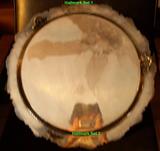Old Large Silver Tray
Posted: Wed Sep 05, 2007 1:19 am
Hello. This is my first time posting here. I've carefully looked through your pages on hallmarks and definitely believe this is a piece of British Silver. However, I am very confused on how to date this item and would like to know what type of silver tray this is.
I took some photos of the whole object itself, which I must apologize for being so poor. My camera or my skills at photography are too poor to properly photograph it. However, the hallmarks below, which a colleague photographed, should be very easy to view.




My guess is that this tray may have been utilized for serving food or holding other items related to dining; perhaps it is serving tray. If my suspicions are correct, though, this try may predate the seventeenth century. If so, perhaps it has some other function of an historical manner that I have not considered. I do not have the try easily accessible to me at this very moment, but it is over 12 inches in diameter.
The first photo shows the front (top) of the tray. The second photo shows the back (bottom) of the tray. The hallmarks are separated into two sets. Each set is across from each such that a straight line, which passes through the center of the piece, may be drawn connecting the two sets. The third photo shows what I've titled on the second picture "Hallmark Set 1". Similarly, the fourth photo shows what I've titled on that same picture "Hallmark Set 2". Does anyone have any ideas as to what purpose this tray may have served throughout its early history?
Regarding Hallmark set 1, the leftmost hallmark seems to be the standard mark which indicates that it is composed of sterling silver. The middle hallmark seems to be the city mark and indicates that the piece is from London and, since it is crowned, that the piece was crafted on or before 1822. The third hallmark is a real mystery to me. Does its being upside-down in relation to the other two marks to its left have any significance? If so, what? Furthermore, is it one of the two marks shown on this site's page explaining the British hallmarks that predates the duty marks? It has quite a different shape though. I'm perplexed by this hallmark. No true duty mark appears on this item. Because of this and the crown on the city hallmark, I believe the item predates 1784.
Regarding Hallmark set 2, I am completely perplexed. What do the two stars indicate? Are they pictographica makers marks? This item clearly lacks any initialed makers mark. If so, then I suspect this item to originate prior to the 17th century. Why are there two stars? Does the number two have any significance? Last, what is the mark in the middle mean? Is it the crowned leopard mentioned in the section describing the duty marks? If so, is this piece Britannia silver? And if so, then how can this be reconciled with the leftmost hallmark in Hallmark set 1 that indicates its being sterling silver?
Any thoughtful remarks to this item will be appreciated.
I took some photos of the whole object itself, which I must apologize for being so poor. My camera or my skills at photography are too poor to properly photograph it. However, the hallmarks below, which a colleague photographed, should be very easy to view.




My guess is that this tray may have been utilized for serving food or holding other items related to dining; perhaps it is serving tray. If my suspicions are correct, though, this try may predate the seventeenth century. If so, perhaps it has some other function of an historical manner that I have not considered. I do not have the try easily accessible to me at this very moment, but it is over 12 inches in diameter.
The first photo shows the front (top) of the tray. The second photo shows the back (bottom) of the tray. The hallmarks are separated into two sets. Each set is across from each such that a straight line, which passes through the center of the piece, may be drawn connecting the two sets. The third photo shows what I've titled on the second picture "Hallmark Set 1". Similarly, the fourth photo shows what I've titled on that same picture "Hallmark Set 2". Does anyone have any ideas as to what purpose this tray may have served throughout its early history?
Regarding Hallmark set 1, the leftmost hallmark seems to be the standard mark which indicates that it is composed of sterling silver. The middle hallmark seems to be the city mark and indicates that the piece is from London and, since it is crowned, that the piece was crafted on or before 1822. The third hallmark is a real mystery to me. Does its being upside-down in relation to the other two marks to its left have any significance? If so, what? Furthermore, is it one of the two marks shown on this site's page explaining the British hallmarks that predates the duty marks? It has quite a different shape though. I'm perplexed by this hallmark. No true duty mark appears on this item. Because of this and the crown on the city hallmark, I believe the item predates 1784.
Regarding Hallmark set 2, I am completely perplexed. What do the two stars indicate? Are they pictographica makers marks? This item clearly lacks any initialed makers mark. If so, then I suspect this item to originate prior to the 17th century. Why are there two stars? Does the number two have any significance? Last, what is the mark in the middle mean? Is it the crowned leopard mentioned in the section describing the duty marks? If so, is this piece Britannia silver? And if so, then how can this be reconciled with the leftmost hallmark in Hallmark set 1 that indicates its being sterling silver?
Any thoughtful remarks to this item will be appreciated.